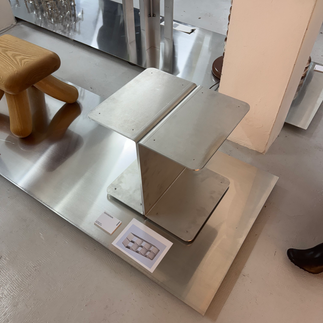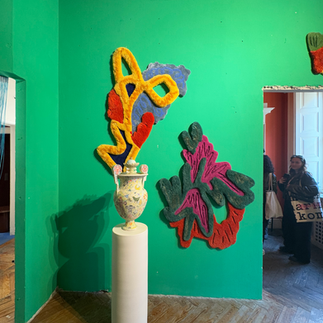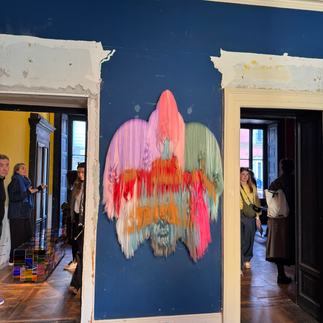🇬🇧 Milan Design Week 2025 : Highlights and perspectives for brands
- Set Design Team

- Apr 19
- 6 min read
Updated: Apr 20
By Sara Ayoub, Kenza Bensaid & Hiba Hilali
"Are you up for joining us in Milan for Design Week?”
We were at La Taverne, a hidden terrace nestled in Gueliz. Over a cup of tea, we made the decision to go as a trio. In no time, our tickets were booked. We landed in Milan with a vibrant group energy — a little electric, very enthusiastic, and ready to see everything (and miss quite a bit as well).
Milan, alongside Turin and Genoa, is part of the industrial triangle that fueled Italy's economic miracle in the 1950s and '60s. What sets Milan apart is its ability to intertwine industrialization with art, architecture, and design, driven by the private sector. After World War II, the Italian industry adopted a unique model, where small entrepreneurs prioritized creative experimentation. It was in this context that great designers like Sergio Asti, Cini Boeri, and Joe Colombo emerged. In 1961, a group of furniture manufacturers founded the Salone del Mobile in Milan, originally dedicated to home furnishings. This event, now globally recognized, has expanded to include lighting, kitchen design, and office furniture, giving rise to numerous Off events throughout central Milan, transforming the city into a true design hub.
This trip was also an opportunity to outline the contours of the contemporary aesthetic matrix and to understand how design shapes the branding universe. When we asked our friends Jo and Ale — seasoned attendees of the circuit — "Should we get our tickets for the Salone?" they laughed: "No way! The OFF is more than enough! And honestly, you’ll have plenty to keep you busy." So we skipped the Salone del Mobile and dove into the OFF: this joyful exploration ground, raw, free, and more experimental.
Design Week is a wonderfully chaotic routine: a lot of walking, a lot of seeing, a lot of missing (and accepting that). Enjoying good food. Meeting strangers and even well-known designers. Sleeping very little. Amidst all this turmoil, certain threads began to emerge.
Ultra-Immersive Experiences
During Milan Design Week, the city transforms into a living laboratory where design is experienced more than it is observed. Immersive installations abound, turning furniture into a language and space into a sensory narrative. Sounds, textures, and stage designs engage visitors in an emotional and accessible experience.
The strength of the fair lies in the constant dialogue between objects and their environment, where the boundaries between art, architecture, fashion, and design blur. Design no longer just furnishes; it creates universes and establishes Milan as the capital of curated creativity.
In venues like Alcova or Spazio Maiocchi, through the works of Objects of Common Interest, Studiopepe, or Laila Gohar, hybrid creations emerge: monumental furniture, habitable sculptures, and ritual installations. Design becomes a sensitive infrastructure and material narrative.
What this means for brands: To stand out in a saturated market, brands must integrate immersive experiences to attract consumers in search of sensations. Narrative techniques and multi-sensory experiences have transformed how we interact with design, making art accessible and alive. These environments serve not just as aesthetic backdrops but become experience platforms that evoke emotions and strengthen the connection between the artwork and the viewer. Immersion thus becomes a powerful means of capturing and holding consumer attention, especially when it intersects two very different universes.
The Intersection of Fashion and Design
During Design Week, luxury Maisons — Prada, Gucci, Hermès, Loewe, Dior, Miu Miu, and Louis Vuitton — made a significant impact with public events that blended fashion and design. Immersive installations, conceptual exhibitions, and unexpected collaborations showcased how these brands effortlessly engage with design.
For example, Gucci unveiled Bamboo Encounters, an initiative that illustrates how design can transcend traditional boundaries. Prada, through its Frames platform, encouraged discussions on global infrastructures, inviting creators to rethink our relationship with urban spaces and the environment.

It's worth noting that fashion and design share a common DNA: creation, aesthetics, and the relationship to objects and space. Design thus becomes a free medium of expression for these houses, allowing them to narrate their stories in new ways. Behind the spectacular scenographies of this Milan Design Week are set designers accustomed to runway shows (Willo Perron, Niklas Bildstein Zaar, Charlotte Macaux Perelman, Alexis Fabry, Studio INI, Dimore Studio, etc.). Universes intersect, disciplines hybridize, and boundaries dissolve.
What this means for brands: The intersection of these worlds enhances brand visibility and appeal by creating experiences that attract a diverse range of consumers. By merging design with fashion, brands can seize opportunities for innovation and expand their reach to untapped markets, all while captivating an audience seeking products that convey luxury. This cross-disciplinary approach not only strengthens brand identity but also fosters deeper connections with consumers who appreciate uniqueness and creativity.
Post-Recession Design: Navigating Between Low-tech, High-tech, and Craftsmanship
The Milan Design Week was marked by overflowing creativity and a true spirit of experimentation around materiality. New ways of designing, producing, and thinking emerged, particularly at Alcova, where the Woven Whispers exhibition explored Belgian textile design, highlighting innovative materials and experimental manufacturing processes. Designer Xavier Servas stood out with his research on natural materials and inflatable structures.
The exhibition also revealed an abundance of cold materials and hard aesthetics, featuring dark scenographies and designs with almost apocalyptic atmospheres. This trend towards more geometric lines and industrial finishes can be interpreted as a response to contemporary uncertainty, where designers explore forms that evoke strength and robustness while playing with visual perceptions of space.
The combination of artificial intelligence and design, featuring fluid and translucent objects (mirrored aluminum, blown glass, 3D prints), created a tension between low-tech and high-tech materials, as seen in the 6:AM exhibition at La Piscina Cozzi. Smart furniture equipped with sensors and automated systems reflects contemporary paradoxes: ecological urgency and the desire for artificiality. Drop City, a futuristic creation hub, showcased advanced prototypes developed using innovative machines and 3D printing tools.
Despite the modern quest for technology, a resurgence of traditional craftsmanship has emerged. Brands like Hermès showcased creations that highlight manual work and expertise, emphasizing the importance of preserving these techniques in contemporary design. This trend goes beyond aesthetics; it conveys a story, a culture, and an authenticity that consumers seek. Handmade pieces tell a narrative, evoking a sense of uniqueness and human connection.
A greater variety of textures, patterns, and volumes is taking shape, with an appreciation for the raw and authentic. At Alcova, pieces combining soft seating, turned wood, and muted ceramic tones reflect a return to craftsmanship, just as at Loewe, where design meets fashion in objects that blend natural fibers and artisanal skills. We also observed a revival of "manufacture": woven, knotted, and embroidered textiles. Rugs were prevalent in various spaces (at Beni Rugs, CC-Tapis, Kooij Studio), alongside curtains and fabric partitions, as if to envelop design, making it more livable and tangible. Brands like Hermès highlight manual craftsmanship, underlining the significance of artisanal skills in contemporary design. This allows brands to differentiate themselves and attract an audience looking for quality, authenticity, and a human connection behind the product.
What this means for brands:
The rise of cold forms and sharp lines reflects a growing acceptance of the post-recession and post-COVID reality. Audiences are now more aware of life's challenges, and brands are embracing this authenticity to counteract overly optimistic narratives that often feel like a demand for constant positivity. In an increasingly saturated market driven by mass production, brands have a responsibility to innovate by subtly integrating technology while showcasing artisanal craftsmanship. This duality is not merely a trend; it is a strategic necessity. Valuing craftsmanship and traditional techniques provides a unique opportunity to emphasize a strong heritage. This approach not only enhances the perceived value of products but also allows consumers to connect with authentic stories instead of superficial features.
Nature Reclaims Its Rights
Paradoxically, there is a clear desire to reintegrate nature into indoor spaces. In an increasingly connected (and let's face it, hostile) world, this quest for natural elements is reflected in the choice of materials such as wood, stone, and even live plants incorporated into design. Brands have begun to employ living plants as decorative elements that not only enhance aesthetics but also purify the air in living spaces.
This yearning for the reintroduction of nature evokes a broader movement toward biomimicry, where design draws inspiration from natural systems to create more harmonious environments. The return to natural materials is also palpable, with stone, wood, bamboo, and clay making a comeback. Installations such as Gucci's Bamboo Encounters and stone sculptures showcased at Alcova illustrate this trend. Stone, notably in forms like Carrara marble, travertine, and chipodigra, blends with raw textiles and totemic objects found at Places of Common Interest, creating a meeting point between nature and futuristic design.
What this means for brands:
Integrating natural elements into communication has become essential, as consumers increasingly seek an authentic connection with nature, even (and especially) in urban environments. Brands must position themselves as change agents by thoughtfully incorporating nature into their messaging and branding strategies. This intentional approach not only resonates with consumers' desires for sustainability and authenticity but also strengthens brand loyalty and engagement. By showcasing a commitment to organic aesthetics and practices, brands can differentiate themselves in a crowded market focused solely on technology.
Ultimately, Milan Design Week allowed us to glimpse a dichotomy in our behaviors and our relationship with the world. Our realities are increasingly connected, yet we paradoxically seek a return to the fundamentals of design through organic materials, craftsmanship, and skill. We are experiencing a technological burnout, responding with a renewed focus on the essence of our humanity: nature and the critical issues surrounding its protection.
As brands navigate this evolving landscape, those that successfully embrace these changes while honoring tradition will undoubtedly stand out in the future.






















































Comments